Wang Pei-Wen (王貝文), a professional cellist, has embarked on a side career as a YouTube personality.
So far, she has uploaded 20 videos to YouTube, featuring herself interviewing A-listers of the classical music world during their visits to Taipei.
The production formula is simple: meticulous prep, gentle questions in English and a single unrehearsed and uninterrupted take. The resulting conversation has lowlights and highlights, which unfold with minimal editing.

Photo courtesy of Wang Pei-wen
“It’s an honest conversation with the world’s great masters of music and art,” she said.
NEW MEDIA STARS
Wang is joining a new group of entertainers who have turned to YouTube to broadcast original homemade content.

Photo courtesy of Wang Pei-wen
In 2007, YouTube launched its Partners program, which granted select users 55 percent of revenue from ads placed through Google AdSense. The system, which has rolled out gradually to general users, opened the gate to online entertainers like Jenna Marbles, who straight-talks and curses heavily while showing off her two dogs, and Hannah Hart (who cooks while intoxicated on the weekly series My Drunk Kitchen). And a tiny but thriving class of Taiwanese artists have taken to YouTube to build their own brand.
Arial Chen (陳沛靖), a young woman who offers health and beauty tutorials, catapulted to fame three years ago with Make Up for Break Up, a video on fixing up a wan visage.
Tsai Wei-chia (蔡緯嘉), who goes by Tsai A-ga (蔡阿嘎), is about to reach a million subscribers with his campy parodies of politicians and social trends. Some YouTube personalities sing and dance: Teng Fu-ju (鄧福如), better known as A-fu, has parlayed her celebrity as a cover artist into a record deal.
Wang is the first in Taiwan to offer regular in-depth interviews with musicians on tour.
Each episode spans 10 to 25 minutes, spotlighting one artist. The lineup includes childhood idol Christine Walevska; violinist and long-time concertmaster of the New York Philharmonic Glenn Dicterow; violinist and UNICEF Goodwill Ambassador Julian Rachlin; and Daniel Muller-Schott, a German cellist who won the International Tchaikovsky Competition in 1992 at age 15.
PRODIGY
Wang herself was a cello prodigy. Born in Taiwan, she trained in the Ministry of Education’s music program until her teens, when she entered Juilliard, one of the US’ top music schools, to attend its pre-college program. After completing college and graduate studies at Juilliard and Yale, she toured the world as a solo and ensemble cellist.
On the show, Wang does not play music with guests. But her know-how as a musician helps take the conversation on interesting turns, from concert hall acoustics to the poetics of piano pedaling. In addition, musicianship helps her build a quick rapport during interviews.
“Over the years, I saw the ups and downs of musicians, I know about it … how hard it is to make a living. I know how to ask questions,” she said.
Some of the guests are her old acquaintances in the music circles.
An episode that aired on Dec. 10 featured Grammy Award-nominated clarinettist David Shifrin, who teaches at Yale. Cellist Wang Jian (王健), who appeared in an Oscar-Award winning documentary featuring Isaac Stern, was her former classmate.
Since the first video aired last May, Wang’s show has attracted about 11,000 views, mainly from the US and Taiwan, but also from the UK, Germany, Hong Kong and Japan.
She is looking to expand her following: experimenting with length and breaking down a single interview into chapters. She is also working on diversifying content, bringing in not just classical musicians but also masters in jazz and other art forms.
Peiwen’s Note: Conversations with the Masters airs on her channel at www.youtube.com/peiwencello. For more information, visit www.peiwensnote.com.

In the March 9 edition of the Taipei Times a piece by Ninon Godefroy ran with the headine “The quiet, gentle rhythm of Taiwan.” It started with the line “Taiwan is a small, humble place. There is no Eiffel Tower, no pyramids — no singular attraction that draws the world’s attention.” I laughed out loud at that. This was out of no disrespect for the author or the piece, which made some interesting analogies and good points about how both Din Tai Fung’s and Taiwan Semiconductor Manufacturing Co’s (TSMC, 台積電) meticulous attention to detail and quality are not quite up to

April 21 to April 27 Hsieh Er’s (謝娥) political fortunes were rising fast after she got out of jail and joined the Chinese Nationalist Party (KMT) in December 1945. Not only did she hold key positions in various committees, she was elected the only woman on the Taipei City Council and headed to Nanjing in 1946 as the sole Taiwanese female representative to the National Constituent Assembly. With the support of first lady Soong May-ling (宋美齡), she started the Taipei Women’s Association and Taiwan Provincial Women’s Association, where she

Chinese Nationalist Party (KMT) Chairman Eric Chu (朱立倫) hatched a bold plan to charge forward and seize the initiative when he held a protest in front of the Taipei City Prosecutors’ Office. Though risky, because illegal, its success would help tackle at least six problems facing both himself and the KMT. What he did not see coming was Taipei Mayor Chiang Wan-an (將萬安) tripping him up out of the gate. In spite of Chu being the most consequential and successful KMT chairman since the early 2010s — arguably saving the party from financial ruin and restoring its electoral viability —

It is one of the more remarkable facts of Taiwan history that it was never occupied or claimed by any of the numerous kingdoms of southern China — Han or otherwise — that lay just across the water from it. None of their brilliant ministers ever discovered that Taiwan was a “core interest” of the state whose annexation was “inevitable.” As Paul Kua notes in an excellent monograph laying out how the Portuguese gave Taiwan the name “Formosa,” the first Europeans to express an interest in occupying Taiwan were the Spanish. Tonio Andrade in his seminal work, How Taiwan Became Chinese,